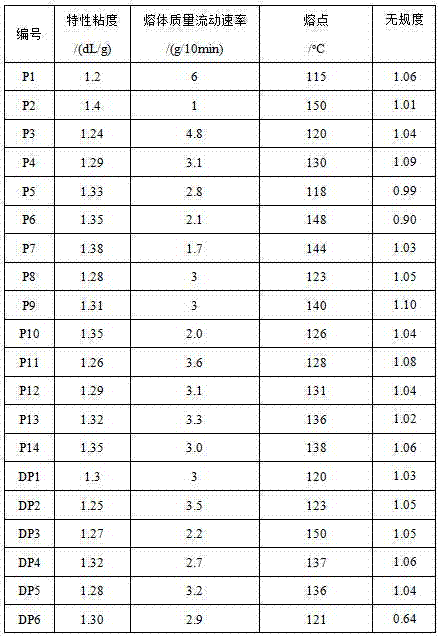Biodegradable aliphatic-aromatic copolyester and application thereof
An aliphatic polyester, biodegradable technology, applied in the polyester field, can solve the problems of unsatisfactory heat preservation and moisturizing effect, low tear resistance of the film, unfavorable industrial production, etc. The probability of hole breakage and the effect of improving the oxygen transmission rate
- Summary
- Abstract
- Description
- Claims
- Application Information
AI Technical Summary
Problems solved by technology
Method used
Image
Examples
Embodiment 1
[0038] Put 8.73 Kg of dimethyl terephthalate and 9 Kg of 1,4-butanediol into the reaction kettle, replace the air in the reaction kettle with nitrogen, then raise the temperature to 170°C, and treat the dimethyl terephthalate After completely melting, 10 g of isopropyl titanate was added, and the temperature was gradually raised to 180° C. for esterification. After the methanol slipping out reaches the theoretical amount, add 7.96 Kg of adipic acid and 142 g of dodecenylsuccinic acid, continue the reaction until the slipping out water reaches the theoretical amount, add 10 g of isopropyl titanate, and gradually heat up to 230~ 250 ° C, about 30 minutes to reduce the pressure in the reactor to below 60Pa, and continue to react under this condition until the power of the stirring motor reaches the set value. Fill the reaction kettle with high-purity nitrogen, extrude the melt through mouth molding, and then draw and pelletize to obtain copolyester, which is marked as P1.
Embodiment 2
[0040] Put 11.64Kg of dimethyl terephthalate, 9Kg of 1,4-butanediol, 5.40Kg of adipic acid, and 684g of octenylsuccinic anhydride into the reactor, and gradually raise the temperature to 170 o C, add 20g of n-butyl titanate, after methanol and water have slipped out to reach the theoretical amount, gradually raise the temperature to 230~250 o C, reduce the pressure in the reactor to below 60Pa in about 30 minutes, and continue to react under this condition until the power of the stirring motor reaches the set value. Fill the reaction kettle with high-purity nitrogen, extrude the melt through the mouth die, and then draw and pelletize the copolyester base material P20. After drying the P20, mix it with 0.6% hexamethylene diisocyanate Reaction in a twin-screw extruder, pelletized to obtain copolyester, marked as P2.
Embodiment 3
[0042] With 8.3Kg of purified terephthalic acid, 8Kg of 1,3-propanediol, drop in the reaction kettle, at 230 o C reacts until the amount of water slipping out reaches the theoretical value, adds 7Kg of adipic acid and 344g of butenyl succinic acid, and continues the reaction until the amount of water slipping out reaches the theoretical value. Add 20g of n-butyl titanate, and gradually raise the temperature to 230~250 oC, reduce the pressure in the reactor to below 60Pa in about 30 minutes, and continue to react under this condition until the power of the stirring motor reaches the set value. Fill the reaction kettle with high-purity nitrogen gas, extrude the melt through mouth molding, and then draw and pelletize the copolyester to obtain copolyester, which is marked as P3.
PUM
| Property | Measurement | Unit |
|---|---|---|
| concentration | aaaaa | aaaaa |
| melt flow index | aaaaa | aaaaa |
Abstract
Description
Claims
Application Information
 Login to View More
Login to View More - R&D
- Intellectual Property
- Life Sciences
- Materials
- Tech Scout
- Unparalleled Data Quality
- Higher Quality Content
- 60% Fewer Hallucinations
Browse by: Latest US Patents, China's latest patents, Technical Efficacy Thesaurus, Application Domain, Technology Topic, Popular Technical Reports.
© 2025 PatSnap. All rights reserved.Legal|Privacy policy|Modern Slavery Act Transparency Statement|Sitemap|About US| Contact US: help@patsnap.com



